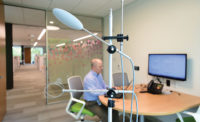Use of handheld devices, on the other hand, will see small but consistent growth by GCs and subcontractors. One factor that may be encouraging steady growth in these markets despite the wider functionality and growing use of tablets could be the perception that they are more durable than tablets. Durability is another factor noted by many contractors as the most necessary improvement to boost productivity through the use of mobile devices. As one respondent says, "[We need] something that is more rugged and can handle work areas. We create a lot of dust."
How Mobile Devices Improve Jobsite Productivity
More than 70% of the contractors chose eight out of 11 tasks in which mobile tools allow them to increase productivity on site, demonstrating that these tools provide a wide range of benefits. When asked to select the one task for which the tools have the greatest impact on productivity, respondents chose a wide range of tasks—demonstrating the variety of ways mobile tools can help increase productivity.
The three top areas are communication and problem solving; collaboration and document sharing; and managing work force, scheduling and tracking work conducted on site.
Communication and Problem Solving
Given the current primacy of smart phones, it is not surprising that communication tasks are the most important ways in which these tools improve jobsite productivity. Subcontractors in particular find communication with the main office to be a primary benefit, with a fifth of them noting this as the most important impact on productivity compared to fewer GCs citing that as a benefit.
The importance of communication is reinforced by other findings in the survey: When asked an open question about why firms allow employees to use their own mobile devices on site, their usefulness for communication was the most common factor cited by all types of respondents.
The main tools that most firms identify as improving productivity are the cameras included in these devices, with 84% of GCs and 77% of subcontractors saying that cameras help improve their productivity.
In fact, 31% of the subcontractors and 29% of GCs consider cameras the most important tool for improving productivity; for subcontractors, cameras are by far the most important tool, with no other tool selected by more than 20%. The ability to deliver immediate photographs of site conditions to others in the organization clearly carries weight.
With growing emphasis on integrated project delivery and shorter design schedules to reduce cost, collaboration and document sharing are becoming increasingly important to GCs.
Sharing project documents and ongoing revisions is considered critical by roughly the same percentage of GCs and subcontractors—with more than a tenth of them selecting it as most important. However, the overall pool that selected using these tools for document sharing is much smaller—61% of GCs already use document-sharing software or apps compared to 40% of subcontractors.
The need to have better document-sharing tools is also noted by several respondents in an open question about the most important improvement needed to help mobile devices boost productivity. One firm seeks "real-time digital plans stored in the cloud and all updated simultaneously so that plans can be changed without everyone working off a different set."
Collaboration
Collaboration ranks as the second most important overall use of mobile tools for GCs, at 12%, twice as many as for subcontractors. However, it is notable that the percentage of GCs rating this as most important is skewed by the strong emphasis that GCs working in the West place on this task—21% of GCs there report collaboration as their biggest use of mobile tools compared to only 3% in the other regions.
Therefore, other than in the West, the results of GCs versus subcontractors on this point are comparable. The result is striking, given that use of mobile tools overall, including their specific use for collaboration, does not differ by region. This may suggest something unique in the West that lends itself to collaborative uses there, making it more important.
Given their importance to collaboration and document sharing, it is notable how few firms cite building information modeling or 3D CAD drawings as tools they use on their mobile devices to increase productivity—making it not even important enough to be included on the chart. This finding may suggest that today's mobile tools, with their relatively small screens and limited functionality, are not sufficient to take advantage of more complex design tools. It could also suggest that there currently are not apps capable of providing enough virtual design value.
Managing the Jobsite Work Force, Scheduling and Tracking Projects
The other major set of tasks for which mobile tools impact productivity revolves around managing work force, scheduling and tracking the progress of work in the field. Managing the work force is a particular priority among subcontractors, who reported this task as more than four times more important than GCs.
The use of project management software or apps is nearly equivalent between GCs and subcontractors, as is their impact on improving productivity for them. Among those using project management software on their mobile devices, about one quarter consider it the most important tool for impacting project productivity, a higher share than all other tools except cameras and project document-sharing software and apps. Clearly, more apps will improve efficiency on the jobsite, similar to how they do today in offices.
Obstacles That Limit Investment in Mobile Tools


Post a comment to this article
Report Abusive Comment